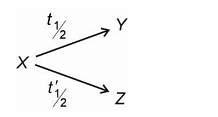The JEE Main Physics section requires speed and accuracy, along with a thorough understanding of the Radioactivity. This article provides a set of JEE Main PYQs on Radioactivity to help you understand the topic and improve your problem-solving skills with the help of detailed solutions by ensuring conceptual clarity, which will help you in the JEE Main 2026 preparation.
Whether you're revising the basics or testing your knowledge, these JEE Main PYQs will serve as a valuable practice resource.
The JEE Main 2026 exam is likely to continue on the same pattern as JEE Main 2025. Out of 90 questions, students can expect a fair mix from all three subjects. To get an edge, going through JEE Main previous year questions (PYQs) is one of the best strategies.
Also Read
JEE Main PYQs on Radioactivity
1.
A radioactive nuclei X decays simultaneously to two nuclei Y and Z as:
t½ is 12 minutes while t'½ is 3 minutes. Find the time in which nuclei X decays 50%.4.8 minutes
15 minutes
2.4 minutes
9 minutes
2.
Following statements related to radioactivity are given below:
(A) Radioactivity is a random and spontaneous process and is dependent on physical and chemical conditions.
(B) The number of un-decayed nuclei in the radioactive sample decays exponentially with time.
(C) Slope of the graph of loge (no. of undecayed nuclei) Vs. time represents the reciprocal of mean life time (τ).
(D) Product of decay constant (λ) and half-life time (T1/2) is not constant.
Choose the most appropriate answer from the options given below:- (A) and (B) only
- (B) and (D) only
- (B) and (C) only
- (C) and (D) only
3.
A radio active material is reduced to 1/8 of its original amount in 3 days.
If 8×10-3 kg of the material is left after 5 days the initial amount of the material is- 32g
- 40g
- 256g
- 64g
4.
How many alpha and beta particles are emitted when Uranium 92U238 decays to lead 82Pb206- 3 alpha particles and 5 beta particles
- 6 alpha particles and 4 beta particles
- 4 alpha particles and 5 beta particles
- 8 alpha particles and 6 beta particles
5.
Two radioactive elements A and B initially have the same number of atoms. The half-life of A is the same as the average life of B. If \( \lambda_A \) and \( \lambda_B \) are the decay constants of A and B respectively, then choose the correct relation from the given options:
\( \lambda_A = 2\lambda_B \)
\( \lambda_A = \lambda_B \)
\( \lambda_A \ln 2 = \lambda_B \)
\( \lambda_A = \lambda_B \ln 2 \)
6.
If a radioactive element with a half-life of 30 min undergoes beta decay. The fraction of the radioactive element that remains undecayed after 90 min is:
- \(\frac{1}{8}\)
- \(\frac{1}{4}\)
- \(\frac{1}{16}\)
- \(\frac{1}{2}\)
7.
The activity of a radioactive material is 6.4 × 10-4 curie. Its half life is 5 days. The activity will become 5 × 10-6 curie after- 7 days
- 15 days
- 25 days
- 35 days







Comments